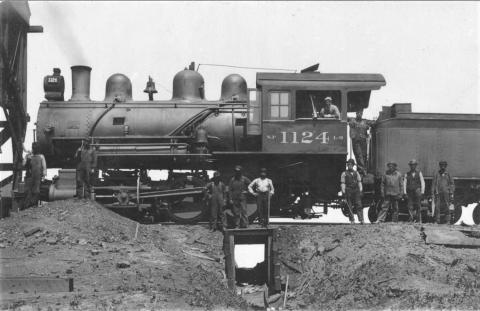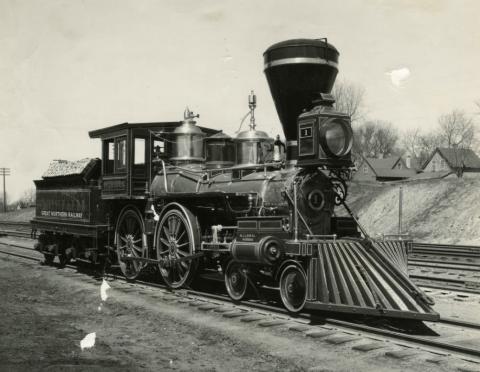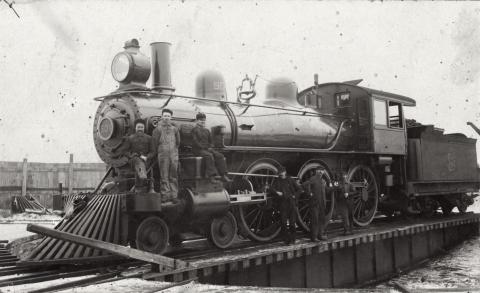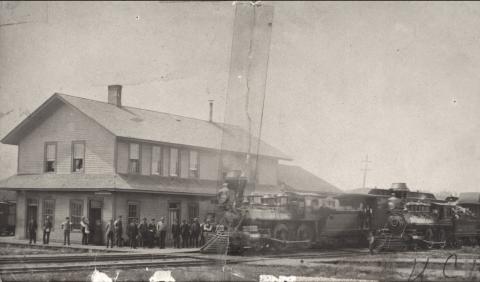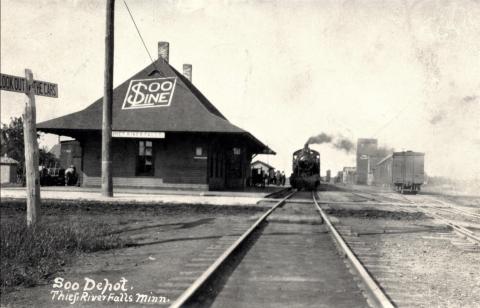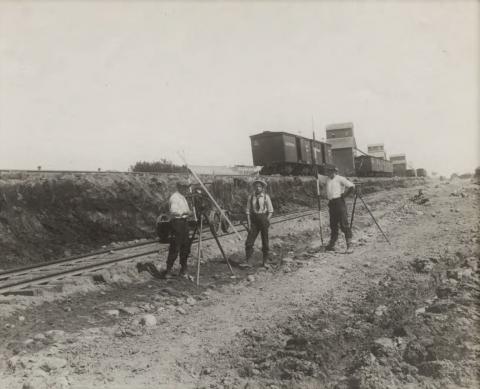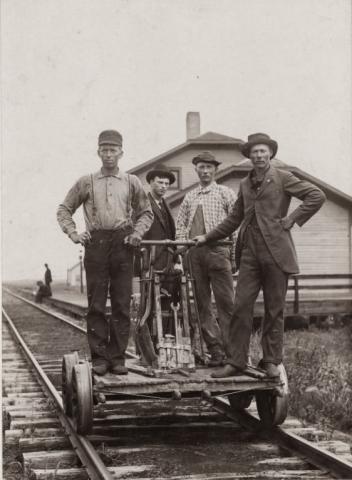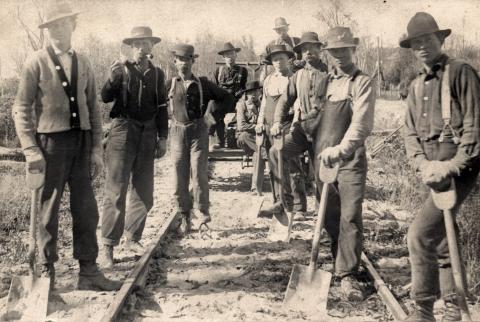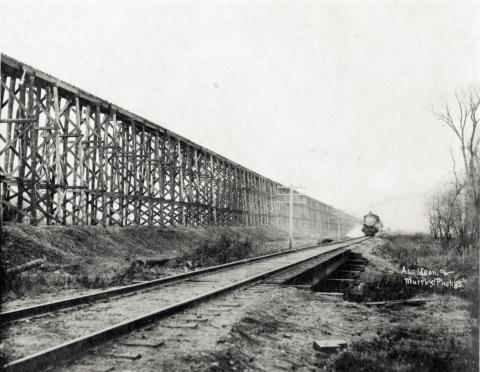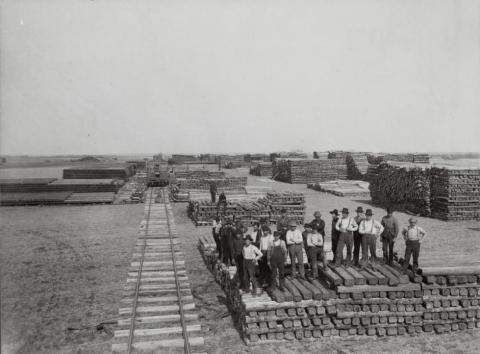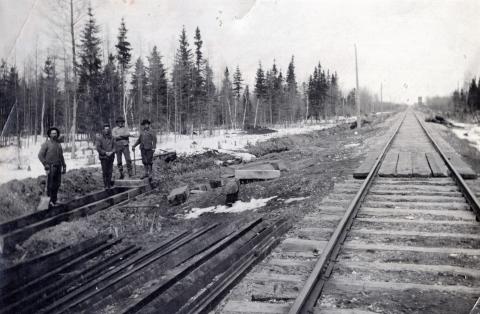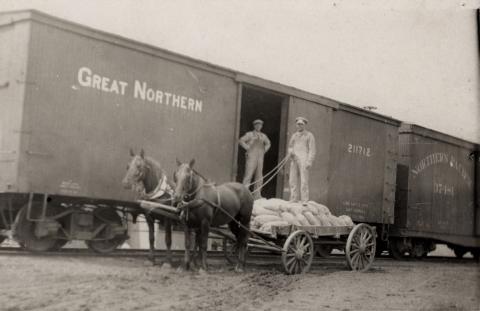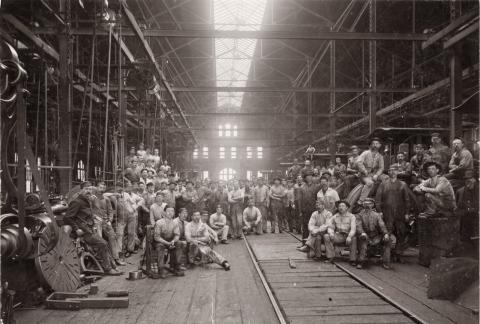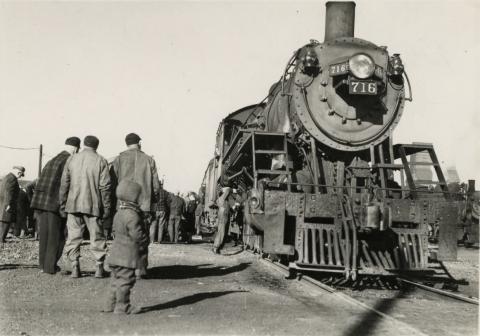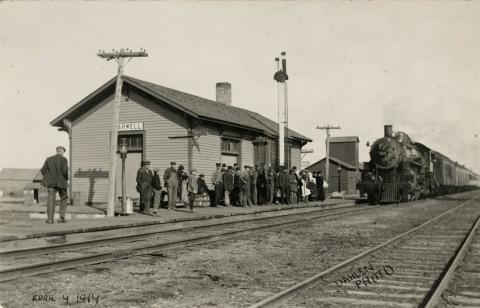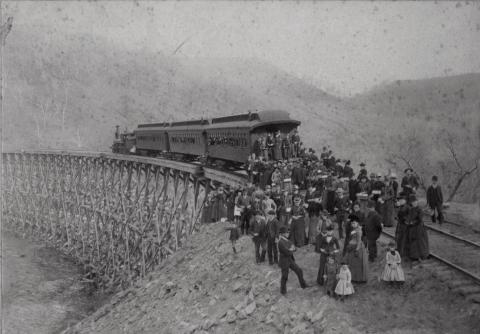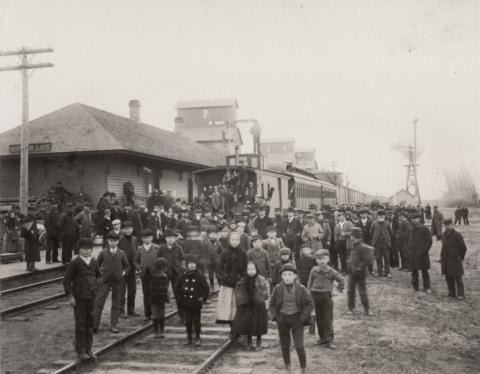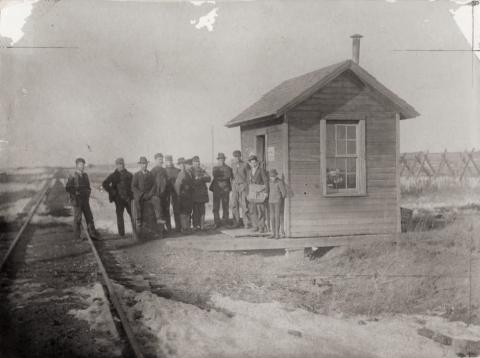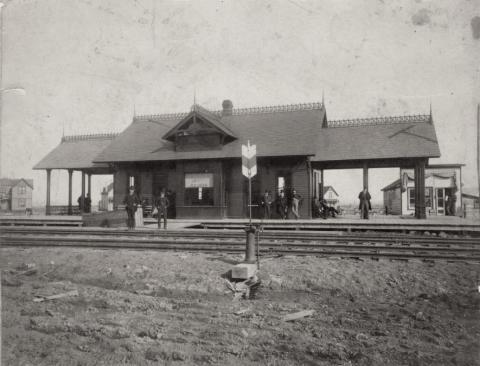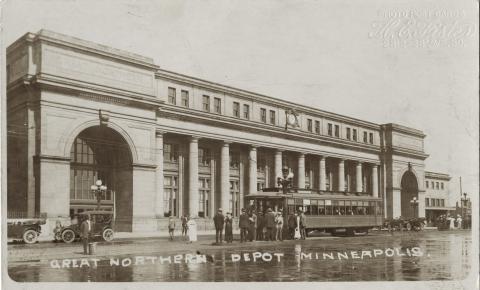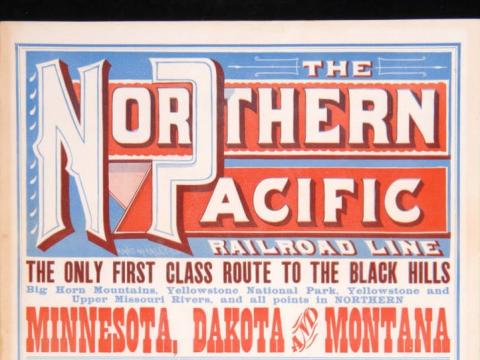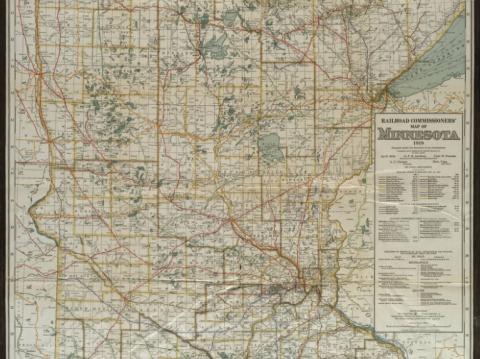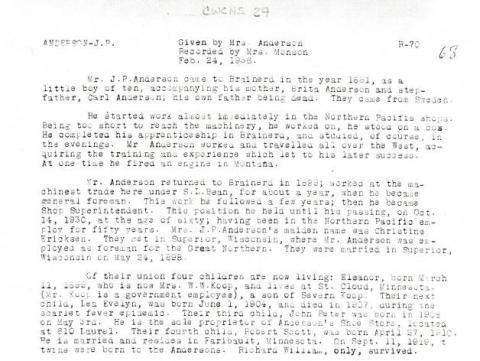Primary Source Set
by Stephanie Hess, Digital Curator, Minnesota Digital Library
Business and Industry Transportation
The growth of Minnesota can be tied directly to the growth of railroads. The railroads supported farmers, millers, miners, and loggers by moving the raw materials they produced to sell at markets. In turn, the railroads brought other goods and products to the people to build their homes, businesses, and towns. Railroads also brought immigrants to settle the land and provided jobs and income to laborers and investors. Three of Minnesota's major railroads were the Northern Pacific, the Great Northern, and the Soo Line. While these three were not the only railroads that operated in Minnesota, they had a major impact on the state.
The U.S. Congress chartered the Northern Pacific Railway in 1864 to build a transcontinental railroad from Lake Superior to the Pacific coast. When it was completed in 1883, the railroad had laid nearly 6,800 miles of track through Minnesota, Wisconsin, North Dakota, Montana, Idaho, Oregon, and Washington. Its headquarters were in St. Paul, Minnesota.
One of the Northern Pacific's main rivals was the Great Northern Railway, created by James J. Hill out of several smaller railways in 1889. By 1893, it also ran trains across the country from St. Paul to Seattle. Like the Northern Pacific, the Great Northern shipped farm products, trade goods, passengers, and immigrants. The Great Northern also shipped lumber and iron ore and helped grow those industries in Minnesota.
Several Minneapolis businessmen formed another major railroad in Minnesota in 1883. They named it the Minneapolis, St. Paul and Sault Ste. Marie Railroad, but it was commonly called the Soo Line (because that's how "Sault" is pronounced). The Soo Line formed to ship grain and flour directly from Minnesota farms to markets in the eastern United States. As the line grew west into Montana, it continued gathering agricultural products, but also transported forest and mine products as well as passengers.
James J. Hill eventually owned part of the Northern Pacific Railway in addition to the Great Northern. In 1970, the two Minnesota-based railroads merged with the Chicago, Burlington and Quincy Railroad Company to become Burlington Northern, Inc. After several mergers, financial issues and splits, the Soo Line also ceased to exist as a separate railway. It became part of the Canadian Pacific Railway in the 1990s.
Discussion Questions & Activities
- How did railroads help Minnesota grow?
- How were people in Minnesota affected by railroads? Look at all the people pictured in the photos above for some ideas.
- The railroads employed lots of people - as laborers laying tracks, surveyors planning the railroad's route, engineers building bridges and trestles, conductors running the locomotives, people loading and unloading goods, machine shop employees building and fixing equipment, depot officials, and more. Look at the photographs of all the railroad employees above. Think about what those jobs would be like: would they be easy or hard? What skills would you need to hold that job? Would you want to work for the railroads?
- Look at the photographs featuring people at depots waiting to get on the trains. Where are they going? What are they bringing? Why are they traveling?
- Railroads built depot buildings, or train stations, for passengers and freight that would be moved by the trains. Compare the different depots in the set above - especially the Okabena one, the Duluth one, and the Great Northern one in Minneapolis. How are these buildings the same? How are they different? Why do you think are they different?
- Look closely at the Northern Pacific advertisement on MDL and make sure to use the zoom tool. Find the places on a map where this railroad would go and draw lines between all the stops mentioned in the ad. Would you want to go to these places? Why? Also, read the bottom section titled "The Railroad and Government Lands." What is this section about? What is the Northern Pacific encouraging people to do? How is it doing this?
- Zoom in on the 1919 Railroad Commissioners' Map on MDL. This map shows the routes of the three railroads described in this set: Northern Pacific (golden line), Great Northern (red), and the Soo Line (green), among many others. Zoom in to find your town. Did these railroads have a station where you live (notated by a circle on a colored line)? Did any of them come close? What other railroads can you see? Use the key on the right side to identify them. Can you find any Minnesota county that did NOT have a railroad line in 1919? Why or why not?
- Read the Interview about J. P. Anderson, a longtime employee of the Northern Pacific Railway. When did he start working for the railroad? What types of jobs did he do? Where did he live? How did his job affect his family? This interview is one of many conducted in the 1930s by the Works Progress Administration (WPA) in Crow Wing County. Read more of these oral histories and compare and contrast the lives of these early people of the county.
eLibrary Minnesota Resources (for Minnesota residents)
Benson, Sonia, et al. "Railroad Industry." UXL Encyclopedia of U.S. History, vol. 7, UXL, 2009, pp. 1288-1293. Gale In Context: High School. Web. Accessed 12 Oct. 2020.
"Great Northern Railway Company." Britannica School, Encyclopædia Britannica, 14 Aug. 2008. Web. Accessed 10 Oct. 2025.
"James J. Hill." Britannica School, Encyclopædia Britannica, 7 Aug. 2020. Web. Accessed 10 Oct. 2025.
“James Jerome Hill.” Columbia Electronic Encyclopedia, 6th Edition, Feb. 2020, p. 1. EBSCOhost. Web. Accessed 10 Oct. 2025.
Kimbrough, Christine K. "Railroads." Dictionary of American History, edited by Stanley I. Kutler, 3rd ed., vol. 7, Charles Scribner's Sons, 2003, pp. 30-40. Gale In Context: High School. Web. Accessed 12 Oct. 2020.
“Northern Pacific Railway.” Columbia Electronic Encyclopedia, 6th Edition, Feb. 2020, p. 1. EBSCOhost. Web. Accessed 12 Oct. 2020.
"Northern Pacific Railway Company." Britannica School, Encyclopædia Britannica, 20 Dec. 2010. Web. Accessed 10 Oct. 2025.
"Railroad." Britannica School, Encyclopædia Britannica, 4 Sep. 2020. Web. Accessed 10 Oct. 2025.
"Railroads, Federal Land Grants to the." Gale Encyclopedia of U.S. Economic History, edited by Thomas Riggs, 2nd ed., vol. 3, Gale, 2015, pp. 1103-1105. Gale In Context: High School. Web. Accessed 12 Oct. 2020.
"The Supreme Court Rules Against Northern Securities, March 14, 1904." DISCovering U.S. History, Gale, 2003. Gale In Context: High School. Web. Accessed 12 Oct. 2020.
Tinsley, Jesse. “Then and Now: Great Northern Railroad.” Spokesman-Review, The (Spokane, WA), 8 Apr. 2019. EBSCOhost. Web. Accessed 12 Oct. 2020.
"Transcontinental Railroad." Gale In Context Online Collection, Gale, 2019. Gale In Context: High School. Web. Accessed 12 Oct. 2020.
Additional Resources for Research
Bruns, Sue. "Great Northern Depot, Bemidji." MNopedia, Minnesota Historical Society. Web. Accessed 6 Oct. 2020.
"Great Northern History." Great Northern Railway Historical Society. Web. Accessed October 6, 2020.
"Great Northern Railway Company." Encyclopaedia Britannica, 2017. Web. Accessed October 12, 2020.
Glischinski, Steve. Minnesota Railroads: A Photographic History, 1940–2012. Minneapolis: University of Minnesota Press, 2012.
Hanson, Aaron. "Great Northern Depot, Minneapolis." MNopedia, Minnesota Historical Society. Web. Accessed October 6, 2020).
Hanson, Aaron. "Great Northern Railway." MNopedia, Minnesota Historical Society. Web. Accessed October 6, 2020.
Hanson, Aaron. "Northern Pacific Railway Como Shops." MNopedia, Minnesota Historical Society. Web. Accessed October 6, 2020.
Hidy, Ralph W. The Great Northern Railway: A History. Minneapolis: University of Minnesota Press, 2004.
Huber, Molly. "Minneapolis, St. Paul and Sault Ste. Marie Railroad (Soo Line)." MNopedia, Minnesota Historical Society. Web. Accessed October 9, 2020.
Johnston, Louis. "Exchange, Industry, and Adaptation: Economics in Minnesota." MNopedia, Minnesota Historical Society. Web. Accessed October 22, 2020.
Luecke, John C. The Great Northern in Minnesota: The Foundations of an Empire. St. Paul: Grenadier Publications, 1997.
Luecke, John. The Northern Pacific in Minnesota. St. Paul: Grenadier Publications, 2005.
McMillan, Tom. "Veterans’ Association of the Great Northern Railway." MNopedia, Minnesota Historical Society. Web. Accessed October 6, 2020.
Nelson, Paul. "Hill, James J. (1838–1916) ." MNopedia, Minnesota Historical Society. Web. Accessed October 6, 2020.
"Northern Pacific Railway Company." Encyclopaedia Britannica, 2013. Web. Accessed October 12, 2020.
"Northern Pacific Railway corporate records, 1861–1970." Manuscript Collection, Minnesota Historical Society, St. Paul. Web. Accessed October 12, 2020.
Northern Pacific Railway Historical Association. Web. Accessed October 12, 2020.
"Railroad Construction." Minnesota Historical Society Library. Web. Accessed October 12, 2020.
"Railroads in Minnesota, 1862-1956." National Register of Historic Places Nomination Form (Washington, DC: U.S. Department of the Interior, National Park Service, 1986), Section E.
The Soo Line Historical and Technical Society. Web. Accessed October 12, 2020.
"Soo Line Railroad Company: An Inventory of Its Company Records at the Minnesota Historical Society." Manuscript Collection, Minnesota Historical Society, St. Paul. Web. Accessed October 12, 2020.
Yenne, Bill. Great Northern Empire Builder. St. Paul: MBI, 2005.
Published onLast Updated on
